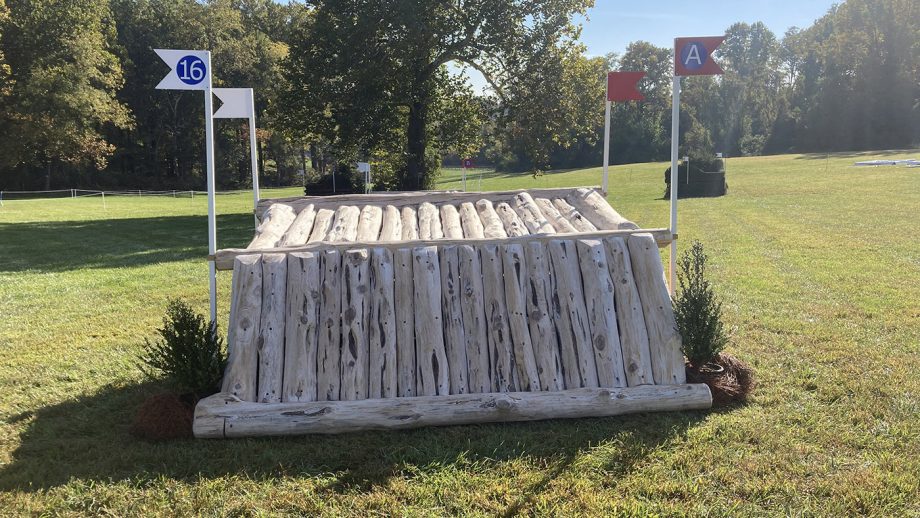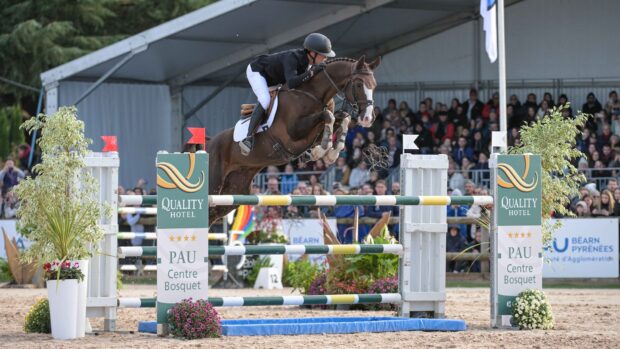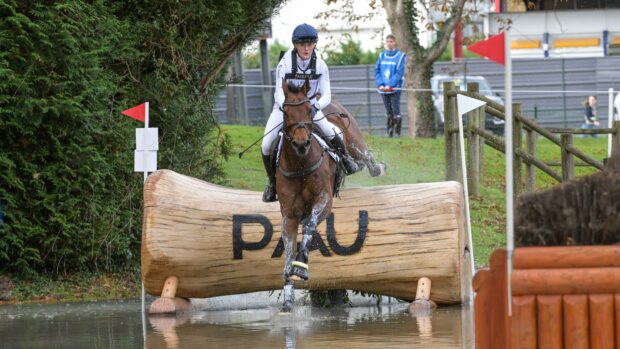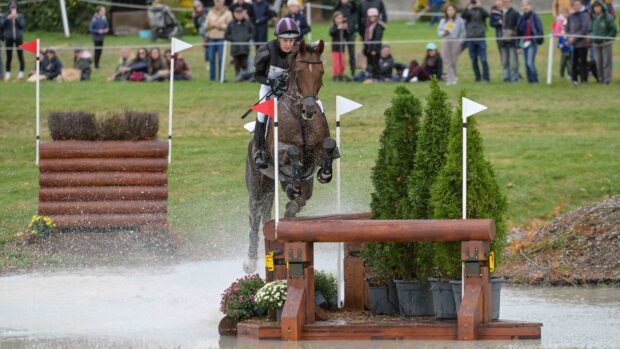Thirteen horses – more than half the starters – made the 11 minute 30 second time over the Mars Maryland 5 Star cross-country course yesterday (15 October). For such a high percentage of horses to make the time at five-star is very unusual and the rate was even higher than last year here, when it was widely acknowledged there had been an error in the measuring of the track.
Overnight leader Tim Price acknowledged that the easy time played into his hands, as he could remain competitive while giving his young horse a good experience, but said: “It was too easy. It wheeled a little bit easy – or quite a bit easy. But I just thought the way the course was this year, it was a little bit more rigorous with the fences. The ground came so good that the horses have just slipped along. So that’s a bit disappointing.”
Asked what officials should do to make the time tighter, Tim said: “Wheel it correctly. All of us had it 15 seconds or about 200m tighter than the official measurement. So they should just try to tighten up on the lines they’re wheeling. I think that’s all it needs. You’ve got to be attentive to the fact another year could be wet and so we don’t want to exaggerate the tightness, just to make it authentic.”
All the riders were at pains to say that Ian Stark is a wonderful course-designer, who has great feel and has created super flow for this track, while acknowledging that this aspect of the Maryland 5 Star cross-country course can be improved.
“It just misses out one very important aspect of the three-day event,” said Harry Meade. “I think there’s a preconceived concern, which is unfounded after two years, that this is very punishing terrain. It’s not hard work like walking the course at Burghley.
“This year the time wheeled slightly easy, about 10 seconds on the lenient side, but it rode about 45 seconds too easy. The measuring of the distance was not the issue – it’s more the layout of this year’s course had been altered to avoid the main hill. On top of that, the majority of the track was built in long straight lines like a steeplechase course, it was only really the last third where it was more like a normal cross-country course.
“It was lovely to ride around but sadly made the cross county test largely a non-event – it didn’t even scratch the surface in testing the ability of the more experienced horses and riders.
“It’s a beautiful course, beautifully presented, brilliantly designed by one of the top experts in the world, it’s just way too gettable in terms of the time.
“It’s the second year running this has been the case; there’s clearly a misconception that this site is super fatiguing for horses, but hopefully the organisers will take confidence from the fact that this is evidently not the case and hopefully that allays any concerns they may have in how they set out the course next year, and they are able to produce a relevant cross county phase.
“If next year it should be wet underfoot, then it is up to us, as riders, to ride accordingly and pace our rounds.”
Jumping efforts within a distance
The average distance per jumping effort will have an influence over how difficult the time is to get on a cross-country course and designers are constrained by the FEI rules in this area.
The Maryland 5 Star cross-country course had the maximum jumping efforts for five-star (45 on the direct routes), with an optimum time of 11 minutes 30 seconds – in the middle of the permitted 11-12 minutes. This resulted in an average of one jumping effort per 146m.
The recent eventing World Championships – run under slightly different permitted parameters – packed the maximum permitted 42 jumping efforts into a time 1 minute 40 second shorter than Maryland’s. This resulted in an average of one jumping effort per 133m, making it likely the time would be more difficult to get than at Maryland, and so it proved.
Of course, distance per jumping effort is just one factor in how tight the time rides – other factors such as terrain, the nature of the jumping efforts and the layout of the track will also play a part.
Perfect weather and going
Conditions will always affect how tightly the time rides and perfect weather and going helped the horses and riders yesterday.
“The ground conditions have been fantastic here the past two years and they can be pretty relentless – the ground can almost be bottomless, so I think Ian is experienced with knowing that,” said US rider Tamie Smith. “I’m not certain that there would be many inside the time if if we’d had the rain that we got last week here.”
Oliver Townend countered: “I don’t think you should ever wheel the time at a five-star pending rain – you wheel it properly and either it rains and we cope or it doesn’t. It was a little bit disappointing [that the time was so easy] and whether Ian says it or not, I know he’ll be quietly disappointed.
“But I can guarantee you as he learns about the venue he’ll start to get more clever about how he’s going to slow everyone down. It’s the second running and he’s changed the course a lot, so it’s nearly like a first time again.
“But we’re all loving the event – we love the course, Ian being designer, but we’re still in the very early stages. We’ll still be back next year. It’s all positive but still needs just one big tweak.”
Maryland 5 Star cross-country course-designer’s view
Course-designer Ian Stark said: “I’m expecting to get a bit of abuse about too many getting inside the time, but for me it was perfect footing, some great riding, some bold and fast and brave riding. I would much rather see 10 get inside the time than five on the floor. So I was a little concerned about so many getting inside the time, but I can live with it.
“Would I have wheeled it any differently? I was pretty tight on the walking and the two technical delegates walked it separately and the three of us were within 20 metres of each other. So how do you walk it differently? Do you cheat? Do you lie? Do you cut in to make it tighter than it is? No, is the answer.
“Various people said to me after last year and will probably say again this year that it would be a better competition if the time was unobtainable but for me with an unobtainable time, there is no limit to how much you push the horses to go faster and if you can’t make it, it’s too demoralising long term for the horses.
“Can I make it tighter? I’m not sure I can. I’m incredibly lucky here with the phenomenal terrain and ground. I’ve very much gone for my philosophy that cross-country riding is going from A to B, not going around in endless demented circles in 20 acres. So I’ve made use of the gallop stretches.
“Maybe I can look at slowing them down a little bit more, at putting in slightly more technical questions – that might be something I think about in the future. But I love today. I’m known as being a bit of a tough person at home sometimes, by my family and friends, and this lot moved me to tears at the end today. I was pretty emotional because I just thought it was a great day and I loved watching it.”
You might also be interested in:

Tim Price and ‘young talent’ lead Maryland 5 Star as dressage leader faults across country

Oliver Townend moves up to podium place at Maryland 5 Star on ‘pony-like’ As Is

Horse returns from broken withers to land Maryland 5 Star second after cross-country

Nine insights on the Maryland 5 Star cross-country course from designer Ian Stark

Subscribe to Horse & Hound magazine today – and enjoy unlimited website access all year round
Keep up with all of the breaking news, behind the scenes insight and the best of the action throughout Maryland 5 Star with no limit on how much you can read from as little as £1 per week with a Horse & Hound unlimited website subscription. Sign up now. Plus enjoy our full magazine report on Maryland, including in-depth analysis and exclusive comment from Mark Phillips, in next week’s magazine (20 October).




